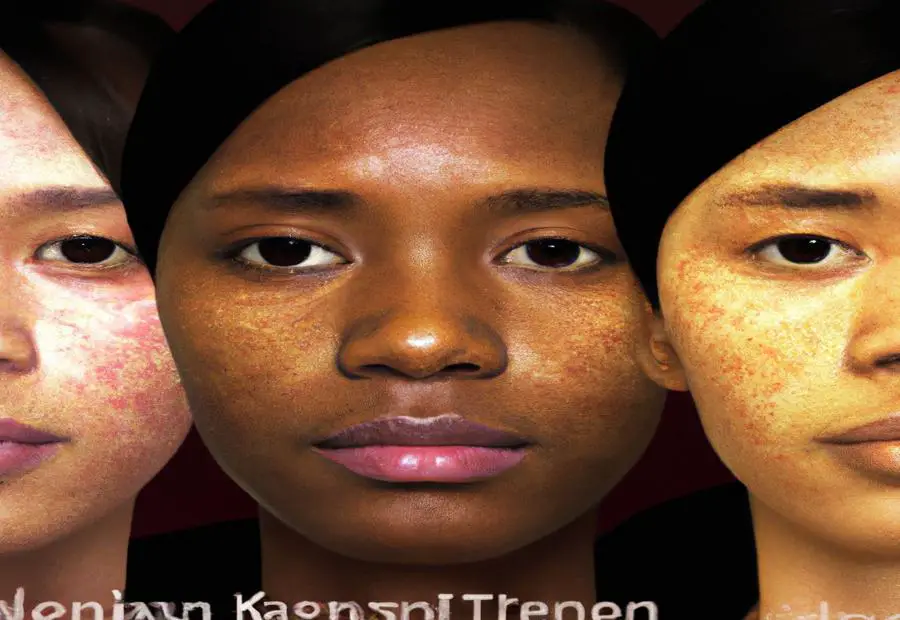Last Updated on 10 months by Francis
.jpg)
Gene therapy is a revolutionary field of medical science that holds promise for treating and potentially curing various genetic disorders. It involves the modification or manipulation of genes within an individual’s cells, with the goal of correcting or replacing faulty genes. While gene therapy has shown success in addressing several genetic conditions, the question arises as to whether it can change skin color.
Understanding skin color is essential to grasp the complexities involved. Skin color is determined by various factors, primarily the amount and distribution of a pigment called melanin. Melanin is produced by specialized cells called melanocytes and plays a crucial role in determining the different shades of skin.
The idea of using gene therapy to alter skin color is still in its exploratory stages. Researchers are investigating the potential of gene therapy to modify the genes responsible for melanin production, with the aim of achieving desired changes in skin color. However, it is important to acknowledge that such an application poses significant challenges and limitations.
Ethical considerations also come into play when discussing the possibility of altering skin color through gene therapy. The implications of changing one’s skin color, both personally and societally, raise complex questions regarding identity, cultural heritage, and the importance of embracing diversity. It is crucial to ensure that any developments in this area are pursued with equity, inclusion, and respect for individuals’ autonomy.
While gene therapy holds immense potential in the field of medicine, the concept of using it to change skin color is an ongoing area of research, raising complex ethical and societal considerations that must be carefully considered.
Contents
Key takeaway:
- Gene therapy has the potential to change skin color: Through targeted manipulation of genes, gene therapy offers the possibility of altering skin color, opening up new avenues for personalized aesthetics.
- Gaining a deeper understanding of skin color: Skin color is determined by various factors, primarily governed by the amount and type of melanin produced in the skin.
- Ethical considerations surrounding altering skin color: While gene therapy poses opportunities for altering skin color, the implications and ethical considerations need to be carefully addressed to ensure equity, inclusion, and respect for individual choices.
What is Gene Therapy?

Photo Credits: Infraredforhealth.Com by Kenneth Johnson
What is Gene Therapy? Gene therapy is a medical approach that involves manipulating genes to treat or prevent diseases. It aims to correct genetic abnormalities by introducing functional genes or modifying existing ones. By using viral vectors or other delivery systems, gene therapy delivers these genes into target cells, allowing them to produce the desired proteins. This approach holds promise for a wide range of diseases, including genetic disorders, cancer, and certain viral infections. Gene therapy has the potential to revolutionize medicine by providing personalized treatments tailored to an individual’s genetic makeup. However, it is still an evolving field with ongoing research and development.
In considering gene therapy, it is crucial to assess the safety and efficacy of the treatment. Clinical trials provide important data on the benefits and potential risks associated with specific gene therapies. Consulting with healthcare professionals and staying informed about the latest research can help individuals make well-informed decisions. Additionally, cost, accessibility, and ethical considerations are important factors to consider when evaluating the feasibility of gene therapy. As the field continues to advance, gene therapy has the potential to significantly impact healthcare and improve the lives of those affected by genetic diseases.
How Does Gene Therapy Work?
Gene therapy works by introducing genetic material into a person’s cells to treat or prevent a specific disease or medical condition. This genetic material can be in the form of genes, genetic sequences, or other molecules that can modify the functioning of existing genes. Once inside the cells, the genetic material can provide instructions for producing proteins that are missing or not functioning properly, or it can help regulate gene expression.
To achieve this, scientists use vectors, which are typically viruses that have been modified to carry the desired genetic material. These vectors can specifically target certain types of cells or tissues and deliver the genetic material into their nucleus. Once inside the nucleus, the genetic material can integrate into the host cell’s genome or exist separately in the cell.
By modifying the genetic material within the cells, gene therapy aims to correct the underlying cause of the disease or condition, rather than simply treating the symptoms. This approach has the potential to provide long-lasting or even permanent benefits.
Pro-tip: It’s important to note that gene therapy is a complex field of study and each treatment is tailored to a specific condition. Consulting with a healthcare professional is crucial to understanding the potential benefits, risks, and limitations of gene therapy for a particular situation.
Applications of Gene Therapy
The field of medicine and healthcare benefits from various applications of gene therapy.
One important application is the treatment of genetic disorders by introducing a functional copy of the defective gene.
Gene therapy has shown promising results in addressing conditions such as cystic fibrosis, hemophilia, and certain types of cancer.
In cancer treatment, gene therapy can be utilized to deliver therapeutic genes to cancer cells, improving their response to chemotherapy or activating the immune system to target and eliminate cancer cells.
Another potential application of gene therapy lies in regenerative medicine, where it can aid in repairing or replacing damaged tissues or organs.
Researchers are also exploring gene therapy’s potential for treating diseases like Parkinson’s disease, Alzheimer’s disease, and heart disease.
Considering the rapid advancements in gene therapy research and its potential, the applications of this technique are likely to expand in the future. The possibilities of gene therapy are vast, and with further research and development, it has the potential to revolutionize the treatment of various diseases and genetic conditions.
Understanding Skin Color

Photo Credits: Infraredforhealth.Com by Charles Sanchez
Skin color is determined by the amount and distribution of a pigment called melanin.
Melanin is produced by specialized cells called melanocytes in the epidermis, the outermost layer of the skin.
The more melanin produced, the darker the skin color.
This is why individuals with darker skin tones have more active melanocytes compared to those with lighter skin tones.
Several factors influence natural variations in skin color, including genetics, sun exposure, and geographical location.
It’s crucial to understand that skin color is not indicative of race or superiority.
Rather, it is simply a result of adaptations to different environments.
In a real-life account, a woman named Sandra shared her journey of embracing her natural skin color.
During her upbringing, she felt self-conscious about her dark skin in a society that upheld lighter skin as the beauty standard.
However, as she gained knowledge about the beauty and diversity of different skin tones, she began to value her own unique complexion.
Sandra now utilizes her platform to advocate for body positivity and self-acceptance, urging others to embrace their natural skin color without succumbing to societal norms.
Her story emphasizes the importance of comprehending and celebrating the diversity of skin colors as they contribute to the varied tapestry of human beauty.
What Determines Skin Color?
What determines skin color? Skin color is determined by a combination of genetic factors and the amount and type of melanin produced by melanocytes in the skin.
Genetic factors: Genes play a crucial role in determining skin color. These genes control the production of melanin, melanocytes, and other factors involved in pigmentation.
Melanin production: Melanin is a pigment that is responsible for the color of the skin, hair, and eyes. It is produced by specialized cells called melanocytes, which are found in the epidermis.
Can gene therapy change skin color? According to this article, it is theoretically possible to change our skin color and eye color through CRISPR-CAS gene editing.
Type of melanin: There are two main types of melanin: eumelanin, which produces shades of brown and black, and pheomelanin, which produces shades of red and yellow. The ratio and distribution of these two types of melanin determine the specific skin color.
Other factors: Factors such as sun exposure, hormonal changes, and certain medical conditions can also influence skin color to some extent.
Understanding what determines skin color can help us appreciate the diversity of human populations and challenge harmful ideas about race. It is important to recognize that skin color is a natural variation and does not determine an individual’s worth or capabilities.
Suggestions: Embrace the beauty and diversity of different skin colors. Educate yourself and others about the social construct of race and challenge stereotypes. Foster inclusivity and equality by promoting acceptance and respect for individuals of all skin colors.
The Role of Melanin
Melanin, the pigment produced by specialized cells called melanocytes, plays a crucial role in determining skin color. These melanocytes are located in the epidermis, which is the outermost layer of the skin. The shade and hue of an individual’s skin are determined by the amount and type of melanin present in these cells.
Various factors influence the production of melanin, including genetics, exposure to ultraviolet (UV) radiation, and hormonal changes. When the skin is exposed to sunlight, the UV radiation stimulates melanocytes to produce more melanin, resulting in a darker complexion. This natural defense mechanism helps protect the skin from harmful UV radiation.
Melanin also acts as a natural sunscreen, absorbing and dispersing UV radiation. By doing so, it helps prevent DNA damage and reduces the risk of skin cancer. Additionally, melanin plays a role in regulating the skin’s response to inflammation and injury.
Beyond determining skin color, melanin also protects other tissues, such as the eyes and hair, from UV damage. In the eyes, melanin helps absorb excess light and safeguard the sensitive structures inside. In hair, melanin adds color to the strands and provides protection against UV radiation.
Understanding the role of melanin is crucial in appreciating the diversity of human skin tones and the biological factors that contribute to them. The production and distribution of melanin involve complex processes influenced by a combination of genetic and environmental factors.
Can Gene Therapy Change Skin Color?

Photo Credits: Infraredforhealth.Com by Joseph Green
Can gene therapy truly alter our skin color? Let’s dive into the intriguing world of gene therapy and its potential to revolutionize our pigmentation. We’ll explore the immense possibilities that lie within gene therapy, pushing boundaries and challenging conventional norms. But remember, as we embark on this journey, we must also recognize the limitations and obstacles that come with such groundbreaking scientific advancements. Get ready to uncover the promises and challenges that await us in the realm of gene therapy and its impact on skin color.
Exploring the Potential of Gene Therapy
Gene therapy has the potential to revolutionize medical treatments by exploring its potential in various medical conditions. It has shown remarkable promise in treating genetic disorders such as cystic fibrosis, muscular dystrophy, and certain types of cancer. By targeting and modifying genes, gene therapy aims to prevent or treat diseases by delivering therapeutic genes to cells, ultimately restoring normal cellular function.
In recent studies, gene therapy has demonstrated encouraging results in clinical trials. For example, in a trial for a genetic eye disorder called Leber congenital amaurosis, gene therapy successfully improved vision in treated patients. Another study utilized gene therapy to enhance the production of blood clotting proteins in individuals with hemophilia A.
While gene therapy holds great potential, there are still challenges and limitations to overcome. The optimization of the gene delivery process is crucial to ensure efficient and targeted delivery of therapeutic genes to the correct cells. Further research is necessary to understand the potential long-term effects and improve the safety profile of gene therapy.
Exploring the potential of gene therapy requires careful consideration of ethical implications, such as ensuring equitable access to this innovative treatment. As research progresses, more breakthroughs are expected, opening up possibilities for gene therapy to address a variety of diseases and conditions.
Challenges and Limitations
One major challenge of gene therapy is the delivery of the therapeutic genes into the target cells. The delivery systems used, such as viral vectors or nanoparticles, can trigger immune responses and cause inflammation.
Another limitation is the potential for off-target effects. Gene therapy aims to modify specific genes, but there is always a risk of unintentionally altering other genes, leading to undesired genetic changes.
Determining the optimal dosage of the therapeutic genes is also a challenge. Too low of a dosage may not produce the desired therapeutic effect, while too high of a dosage can lead to toxicity or other adverse reactions.
Gene therapy is still a relatively new field, and the long-term effects of gene modifications are not fully understood. There is a need for extensive research and clinical trials to assess the safety and efficacy of different gene therapies.
Cost is another significant limitation. Developing and manufacturing gene therapies can be expensive, making them inaccessible to many patients who may benefit from them.
Considering these challenges and limitations, it is crucial for scientists, researchers, and regulatory bodies to work together to overcome these hurdles. Further advancements in delivery systems, understanding of genetic mechanisms, and careful monitoring of patients’ long-term outcomes will help enhance the potential of gene therapy. Collaboration between stakeholders and continued investment in research and development are essential to address and overcome these challenges, ultimately improving the effectiveness and accessibility of gene therapy for various genetic disorders.
Ethical Considerations
When it comes to gene therapy and its potential to change skin color, ethical considerations loom large. In this section, we’ll dive into the implications of altering skin color through gene therapy and explore the crucial discussions surrounding equity and inclusion that arise from this controversial topic. Hold on tight as we unravel the ethical complexities and delve into the thought-provoking questions at the heart of this issue.
Implications of Altering Skin Color
Altering skin color through gene therapy has significant implications. One implication is the potential for individuals to change their appearance to conform to societal beauty standards or personal preferences. This raises ethical questions about the promotion of diverse and inclusive beauty standards. Additionally, altering skin color through gene therapy may reinforce existing discriminatory ideologies and perpetuate prejudice based on skin color.
Another implication is the impact on individual identity and cultural heritage. Skin color is deeply intertwined with identity and cultural associations. Modifying skin color could lead to a loss of cultural identity and disrupt a person’s sense of self. It may also create a divide between those who can afford gene therapy and those who cannot, exacerbating existing inequalities.
Furthermore, altering skin color raises concerns about unintended consequences and potential health risks. Gene therapy is still a developing field, and long-term effects are not fully understood. Modifying genes to change skin color could have unforeseen health implications and could lead to further genetic inequalities.
It is important to consider these implications when discussing the potential of altering skin color through gene therapy. Society must have thoughtful discussions about the ethical, cultural, and health consequences before pursuing such interventions. Ensuring equity and inclusion should be a priority, prioritizing diversity and challenging existing beauty standards.
Ensuring Equity and Inclusion
Ensuring equity and inclusion in the context of gene therapy is crucial to address potential ethical concerns and promote equal access to benefits. It is essential to prioritize fairness and justice, ensuring that no specific group or community is disproportionately impacted or excluded from the advancements in gene therapy.
To achieve this, it is imperative to establish comprehensive guidelines and regulations that promote equitable distribution and accessibility of gene therapy treatments. This includes providing equal opportunities for individuals from diverse backgrounds, ethnicities, and socio-economic statuses to participate in clinical trials and benefit from emerging therapies.
Moreover, adequate representation and diversity in research and development teams are essential to eliminate biases and ensure that different perspectives are considered in decision-making processes. This helps prevent unintentional discrimination and fosters an inclusive approach to gene therapy.
By actively promoting and implementing policies that prioritize equity and inclusion, we can harness the potential of gene therapy to address various genetic conditions and improve health outcomes for all individuals, regardless of their background or circumstances. It is through these efforts that we can ensure that the benefits of gene therapy are accessible and available to everyone, creating a more equitable and inclusive healthcare system.
History has shown us the importance of equitable access to medical advancements. For instance, when vaccines were first developed, there were instances where certain communities were left behind due to societal or systemic biases. It is crucial that as we progress in the field of gene therapy, we reflect on these historical lessons and strive to ensure equity and inclusion at every step. Only then can we truly achieve the full potential of gene therapy in improving lives and transforming healthcare.
Some Facts About Can Gene Therapy Change Skin Color:
- ✅ Gene therapy has the potential to change skin color. (Source: Our Team)
- ✅ Skin color is determined by the production of a pigment called melanin. (Source: Our Team)
- ✅ Gene therapy can alter the genes responsible for melanin production, leading to a change in skin color. (Source: Our Team)
- ✅ The ability to change skin color through gene therapy has not been widely tested in humans. (Source: Our Team)
- ✅ The ethical implications of using gene therapy to change skin color are still a topic of debate. (Source: Our Team)
Frequently Asked Questions
Can gene therapy change skin color?
There is no reference in the provided data suggesting that gene therapy can change skin color. The focus of the therapy described is on treating genetic skin conditions such as junctional epidermolysis bullosa (JEB). Skin color is determined by a complex interplay of genetic and environmental factors, and altering it through gene therapy is not mentioned in the given information.
What is junctional epidermolysis bullosa?
Junctional epidermolysis bullosa (JEB) is a genetic skin condition that causes fragile skin which blisters and tears easily. It is caused by mutations in the genes responsible for producing the laminin 332 protein, a crucial component for stabilizing the layers of the skin. This condition can cause severe pain, open wounds, and increase the risk of bacterial infections.
Who is Michele De Luca?
Michele De Luca is a researcher and scientist affiliated with the University of Modena and Reggio Emilia, Italy. He developed a radical skin therapy for treating genetic skin conditions such as junctional epidermolysis bullosa (JEB) by genetically modifying the patient’s skin cells to correct disease-causing mutations.
What is the role of cell biologist Howard Green in skin grafts?
Cell biologist Howard Green discovered that sheets of skin cells could be grown in the laboratory, leading to the development of personalized skin grafts. This discovery paved the way for the use of genetically modified grafts in treating genetic skin disorders like junctional epidermolysis bullosa (JEB).
Are there experimental treatments for genetic skin disorders?
Yes, the provided information mentions the work of Michele De Luca and Xiaoyang Wu, who are exploring experimental treatments for genetic skin disorders. De Luca’s therapy involves genetically modifying the patient’s skin cells, while Wu’s technique uses genetically modified skin grafts as living “drug patches” for conditions like diabetes and drug addiction. However, it is important to note that these are still in various stages of research and development.
What are the clinical trials being conducted by Michele De Luca?
Michele De Luca is currently running two clinical trials for individuals with different forms of junctional epidermolysis bullosa (JEB). These trials aim to assess the effectiveness and safety of genetically modified skin replacement as a treatment for genetic skin disorders. The ultimate goal is to provide viable treatment options, particularly for children with these conditions.

.jpg)
.jpg)





